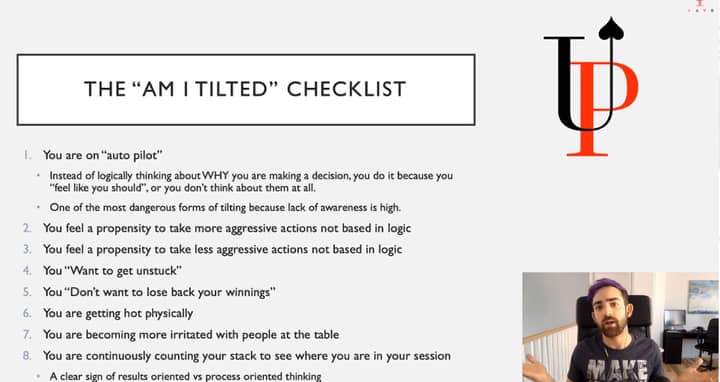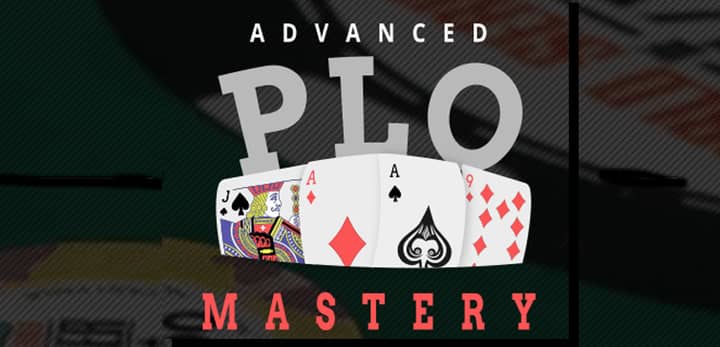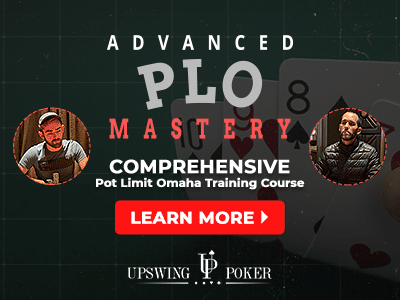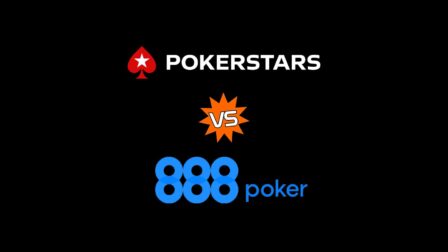Advanced PLO Mastery Review – Pot Limit Omaha Course by Upswing Poker
Pot Limit Omaha has been gaining more and more popularity as of late, especially in the online poker world.
With many advanced training courses for No-Limit Hold’em making games increasingly tougher, players are looking for a new game where they could have a bigger edge.
PLO seems to be the number one choice in this category. The amount of resources for the game isn’t nearly as big as that for NLHE, so those willing to put in the work can definitely get ahead of the curve.
For those looking to push the envelope, Advanced PLO Mastery Course offers everything you could possibly ask for and more. Check it out yourself!
This is the latest course developed by Upswing poker, focusing primarily on 6-max PLO cash games, although parts of it touch upon MTT play as well.
The course is taught by Dylan Weisman and Chris Wehner, two players with excellent credentials.
Weisman started playing poker when he was 16, focusing primarily on Pot Limit Omaha. He found a lot of success online playing under the moniker “iheartco0kie” as well as in the live setting, playing highest stakes games Vegas has to offer.
On top of his poker knowledge, Dylan also graduated from USCB, and his college education helped him understand other skills required to be a successful poker player.
Chris “bluffmasta” Wehner started playing poker during his high school days. Although his earliest poker playing days were rough, he recognized the value and the potential of studying the game.
He’s developed a theory-based approach revolving around fundamentals, and this is exactly the kind of approach he brings to the Advanced PLO Mastery Course.
Navigation
Advanced PLO Mastery at a Glance
With the introduction out of the way, it’s time to move on to the actual review of Advanced PLO Mastery by Upswing Poker. You’re probably wondering what kind of a course this is and who is it made for?
Even after watching a few introductory videos, it becomes clear that this isn’t a PLO course for novice players.
While you could still get a lot of valuable information from it, you should probably hone your skills with some simpler lessons before jumping into this one. For example, you can take a more beginner-friendly PLO Lab option.
However, if you’ve been playing PLO for some time and are now looking for a way to take your game to the next level, Advanced PLO Mastery might be just what you need.
It is a very detailed and nicely presented course that covers pretty much every aspect of the game. The knowledge is definitely there for the taking but only for those willing to do the work.

A bulk of this course revolves around calculations created using MonkerSolver, a piece of software that’s very powerful for finding answers for almost any PLO situation.
However, this math-heavy approach means that you’ll need to stay focused during lessons, make notes, and truly apply yourself to get your money’s worth.
If this doesn’t sound like something you would enjoy or you don’t feel you’d have the time for it, this isn’t the course for you.
Wehner and Weisman are very honest about it right from the get-go. They don’t promise you a magic pill that will make you a better player overnight. They promise plenty of resources and wealth of knowledge for you to explore, and they deliver on that promise. But you will need to do your part.
Course Structure
Like other Upswing Poker courses, this one is also divided into several large categories, namely:
- Intro
- Preflop
- Flop
- Turn
- River
- Centralized Spotlights
- Professional Fundamentals
- Play & Explains
The intro section helps ease you into the course, explaining the structure and also introducing the tools used during the lessons, most importantly, MonkerSolver.
If you are new to this software, you should definitely check out the intro section as it will make keeping up with what comes next much easier.
In this section, you also get advice on how to get the most value from the information presented. As I’ve already explained, Advanced Pot-Limit Omaha Mastery requires you to do some work on your own, and here you will learn how to do it.
On top of all the video lessons, you’ll also get a variety of downloadable charts as well as quizzes for different sections.
These poker quizzes represent an excellent tool to check your newly found knowledge.
Course creators suggest you take these a day or two after watching the actual lessons to make sure you’ve adopted concepts and ideas explained in the videos.
While Weisman and Wehner try their best to make the course as fun and as entertaining as possible, some of it is just “boring” – but it is also necessary if you want to become a better PLO player.
Advanced PLO Mastery: Preflop
The actual theoretical part of the course starts at the very beginning, i.e., with preflop. Like in Hold’em, knowing what hands to play from what position is essential for your success.
However, unlike Hold’em, PLO offers 270,725 different starting hands. So, memorizing your starting hands can be a rather daunting task.

The preflop section offers a dozen videos covering different important areas of the game, with a heavy focus on the Raise First In (RFI) spots.
RFI
This is a two-part miniseries that explains everything you need to know about what hands to open from what position in a 6-max PLO game.
For the sake of simplicity, all hands in this and other sections assume 100 big blinds effective stacks and the raise size of full pot unless otherwise stated.
Since you don’t have the benefit of visualizing that 13×13 grid that you may be accustomed to from No-Limit Hold’em, a different approach is required. Wehner does a very good job of explaining how to go about creating your RFI ranges.
He explains that it is possible to arrange hands by either class or position. The latter of the two is a popular approach in NLHE, but it doesn’t work for PLO because there are so many starting hand combos that you’d have to add thousands of new hands for each position.
So, instead, he prefers the approach categorizing hands by class and using the concept of the “worst open.”
He breaks down hands into 15 different categories further divided into subcategories according to suitedness.
After this, he goes through these different poker hand categories by positions and explains how you can use this idea of the “worst open” to make life much easier for yourself.
This is also the first section where the impact of rake is discussed, and you’ll get to hear much more about it moving forward.
Rake can be a very important factor when you are deciding how to play your hands, and it’s nice to see Wehner acknowledges this fact and gives it the attention it deserves.

Finally, you’re given some more tips on how to go about studying and memorizing all this new information.
Weisman suggests using handmade flashcards, which may seem like an outdated and rather strange approach in this day and age, but don’t knock it until you try it. It can be very effective and help you remember stuff much better.
None of this may seem super-exciting. However, you can’t improve your game without very solid preflop fundamentals, and these videos provide you with the information you need to do just that.
So, take your time with them, because you’re going to need them in future lessons and your day-to-day games.
Cold Calls & Blind Defense
The second section of the preflop part of the course deals with cold calls and blind defense, but only where that defense is passive (i.e., calling).
Once again, the impact of rake is emphasized and how you should be less inclined to play passively in higher-raked games.
The video also touches upon a very important concept that you shouldn’t be getting involved in multiway pots with mediocre hands despite seemingly good pot odds.
Many mediocre hands lose a lot of value in these situations, and you should err on the side of caution due to reversed implied odds.
3-betting & Squeezing
Final videos in the preflop section deal with 3-bets, squeezes, and defending against 3-bets. Unlike passive actions, aggressive actions such as 3-bets aren’t nearly as penalized by the rake, so there is no much difference between ranges at PLO200 and PLO2000.
Also, it is interesting to see that the 3-betting range doesn’t change as much with the position.
Unlike flat calling, which is often a favorable option on the button, you don’t want your 3-betting range to get much wider as you get closer to the button. Simply put, the positional advantage isn’t nearly as important in 3-bet pots.
When talking about defending against 3-bets, Wehner introduces an interesting idea of the “possibility effect” and talks about how players often tend to call too much in these spots because they tend to focus more on potentially favorable flops.
He explains how this way of thinking can be very dangerous and have serious implications on your bottom line, and how to avoid it.
Advanced PLO Mastery Review: The Flop
If you thought the preflop stuff was complicated, you’re in for a surprise with the flop section. With so many different board textures possible, there is no simple way to approach the flop play, so this particular section of the course will take you on a really deep dive.
You will get all the tools you need to learn what’s being presented in these videos and even a detailed explanation of how to interact with them for the best results.
However, you’ll have to spend a fair few hours doing the work yourself and soaking in what’s being discussed if you want to take full advantage of the knowledge presented in Advanced PLO Mastery by Upswing Poker.
The flop section is split into two main parts:
- single raised pots
- 3-bet pots
Both of these contain several videos further broken down by board textures and positional considerations.
Single Raised Pots
The first video on single raised pots is very important as it discusses the overall strategic approach to flop play.
Pot Limit Omaha is a complicated game, so your goal isn’t necessarily to find the optimal strategy for every spot. Rather, you want to develop a solid strategy that’s also not overly complicated so that you can actually learn and implement it.

This is where the game tree is explained as well, and you’ll see just how fast things can get dicey with numerous decisions available along the way.
That’s a reason more to try and stick to simpler solutions when it comes to bet sizing and other considerations because it is okay to sacrifice some theoretical value for the sake of simplicity.
Videos in this PLO Mastery section are categorized by the board types, namely:
- Dynamic unpaired boards
- Dry unpaired boards
- Straight boards
- Paired boards
- Monotone boards
3-bet Pots
The section of the course covering the flop play in 3-bet pots continues on the previous lessons.
Here, videos are organized by the position (IP and OOP) and aggression (are you playing as a 3-bettor or as a caller).
Wehner goes through different scenarios for all the different types of boards presented in the single raised pots section, and by the end of it, you’ll have a deep understanding of play in 3-bet pots, no matter the scenario.
Advanced PLO Mastery by Upswing Poker: The Turn
The Turn section continues on everything that’s been discussed thus far, so it is really important to watch these videos in the order they’re presented in the Advanced PLO Mastery course.
The information about the preflop and flop play is essential to understanding turn strategies.
It is also the point in the course where you’ll need to keep an open mind. Unlike the previous two sections, this one requires a deeper level of understanding as things start to get less generic and you need to think deeper about poker hands.
In fact, according to Weisman and Wehner, it is on the turn where many players start to lose the plot, which makes this an ideal spot to make money.

However, if you want to make most out of what’s being presented, you’ll need to tune in and stay focused throughout.
This isn’t the kind of material you’ll be able to watch on auto-pilot and just rush through it.
Covered topics include:
- Turn probes
- Delayed c-betting
- Responding to delayed c-bets
- Double barreling turns
- Raising turn probes
Unlike previous lessons, you don’t have to watch these in a particular order as each section covers a particular area of the game.
So, you can focus more on a certain topic that you’re most interested in and believe would help your game the most.
For every topic, you’ll find two videos. One is explaining general concepts, while the second one is a deep dive with MonkerSolver examples and detailed calculations.
PLO Mastery by Upswing Poker: The River
Not surprisingly, the River play section of the course is, in a way, a culmination of everything that’s been presented thus far.
These videos expand on the ideas already covered and require you to already understand many important concepts like the range advantage, how to interact with equity graphs, etc.
The only correct way to think about river spots is through these concepts, so it is at this point in the course that you’ll be referred back to previous lessons if you feel like you aren’t keeping up with the content.
As for the lessons found in this section, these are:
- Playing OOP & IP after the flop and turn check through
- Bet-check-bet lines
- Finding bluff raises on the river
- Finding follow-through bluffs
- Leading rivers as the turn defender
- Triple-barreling

Just like the turn section, every topic consists of two videos. One is explaining general concepts while the other is more of a deep dive-style video that goes into detail of numbers and stats behind your river decisions in specific spots.
PLO Mastery: Centralized Spotlights
Although learning PLO poker rules isn’t a walk in the park, PLO Mastery creators have certainly done their best to make it as easy as possible.
After offering detailed and comprehensive strategy guides for every single street, the Centralized Spotlights section offers several videos designed to help you better organize your newly acquired knowledge and focus on certain important topics such as:
- Preflop mistakes you’re probably making. This video is about some usual preflop mistakes, and it’s not a substitute for the preflop series. Rather, it offers some condensed advice that should help you make fewer errors when choosing your starting hands.
- Flush completing turns. Flushes are a big deal in PLO, and dealing with flush completing cards on turns can be quite tricky, so this lesson offers some additional advice on the topic.
- Debunking outdated ways of thinking. These are very interesting videos well worth watching as they do away with some outdated concepts such as the importance of the initiative and protecting your equity.
- MTT strategy. Several videos in this section of Advanced PLO Mastery cover the tournament play, which is a nice addition to the course as the bulk of it is focused on 6-max cash games.
Advanced PLO Mastery Review: Professional Fundamentals
Playing this game isn’t just about knowing basic poker rules or strategies, especially if you’re looking to compete at the highest level and make a living doing it.
Seeing how this course is geared towards serious players (and those striving to become serious players), the Professional Fundamentals section is a very nice and welcome addition.
Unlike the rest of the Upswing Advanced PLO Mastery course, it doesn’t talk as much about Pot Limit Omaha but rather about things that you need to do to put yourself in a position to not only become a successful player but be happy doing it.

This is where Dylan Weisman’s education comes through as he offers many great tips on how you should think about poker and yourself as a person to set yourself up for success.
Feel free to watch these videos whenever you like, as you don’t need to go through the entire course before watching them.
In fact, they can be quite inspiring, so if you find yourself struggling with your learning curve, maybe skip to this section for a little while and check out some of the lessons.
And, if you’re really into learning PLO, the final two videos of this section offer you a deep and detailed explanation of MonkerSolver.
These videos will provide you with the knowledge necessary to run your own simulations or double-check the results presented throughout the course.
This is not for everybody, and it’s the densest material in the entire course by far, but it’s nice to have it in there for those who are really hungry for knowledge.
Advanced PLO Mastery: Play & Explains
The Play & Explains section offers several hours of detailed analysis of PLO hands played both live and online.
You’ll find references to many of the things discussed throughout the course in these videos, and they represent a great way to round up and test your knowledge.

While these can be watched before you go through the entire course (and they are definitely fun to watch), you’ll get much more value out of them if you stay patient and start going through them after watching the entire theoretical part of the course at least once.
Conclusion + EXTRA BONUS: Is Advanced PLO Mastery Worth Buying?
After going through the entire course and checking out all it has to offer, it is time to answer the most important question that’s probably on your mind right now. Is the Advanced PLO Mastery course by Upswing worth buying?
Based on the volume and the quality of the material contained inside, the answer is really simple.
Yes, this course is well worth the money as it will improve your knowledge of PLO so much that you’ll easily make up for the cost in no time.
However…
Don’t buy this course, thinking it will magically make you a PLO monster. The only way you’ll get value from Advance PLO Mastery is if you’re prepared to take time to go through it slowly and understand the concepts and ideas explained inside.
A bulk of the content is math-heavy as well, so don’t expect too many hand play examples (except for the final section). This course strives to teach you complicated theoretical fundamentals of PLO, and that’s not something that’s just going to happen by accident.
If you’re ready to do the work and love the numbers, then Advanced PLO Mastery is perfect for you, and you’ll get more than your money’s worth.
EXTRA BONUS
EXTRA BONUS: I am an affiliate for the Advanced PLO Mastery course, and will get a commission if you sign up through my link. That being said, I am ready to give that commission back and even add some on top to you in the form of an EXTRA bonus worth €397 when you join through this link.
Just contact me if you enroll in Advanced PLO Mastery training, and I will give you a great course about live play nuances, which will help you excel further when playing live!






















